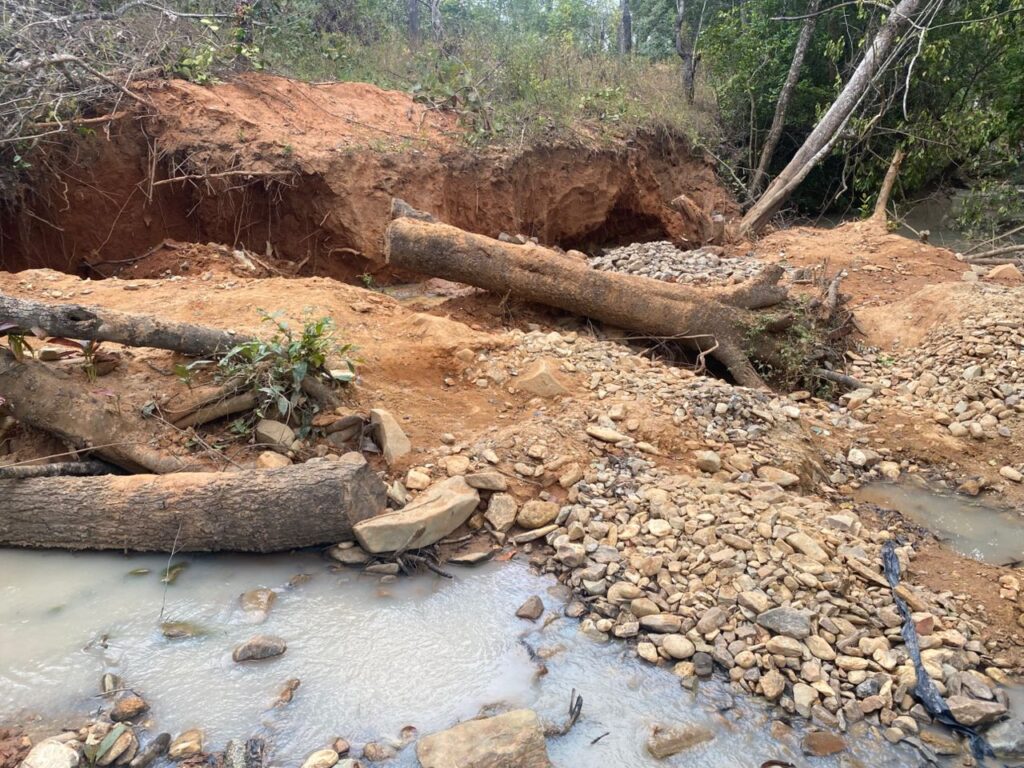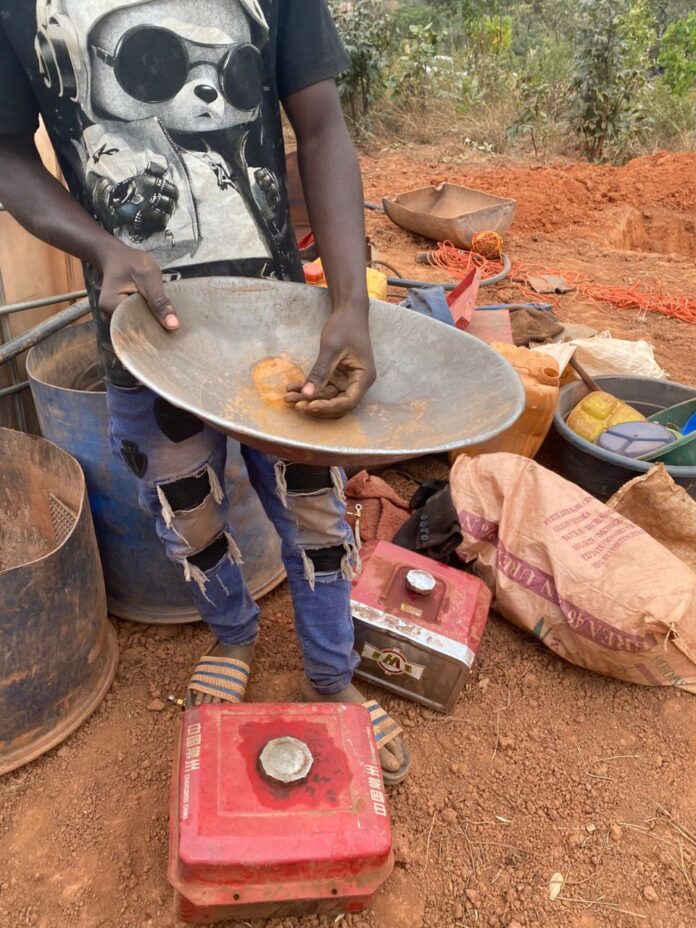Despite government pledges to formalise small-scale mining, chaos and contamination continue to define Muchinga’s unfolding gold rush. Fortune seekers flood Muchinga’s rivers, leaving behind pollution, broken promises, and shattered communities.
By Sandra Kunda
Across Muchinga, the lure of gold has turned rivers into dig sites and forests into camps, pitting survival against sustainability.
In Chipowe village, deep within Mukungule in Mpika district of northern Zambia, 32-year-old Idah Mupeta sits outside her grass-thatched hut, a container of discoloured water by her side.
“We used to drink this water,” she says quietly. “Now even the goats hesitate.”
Upstream at Kamabwe mine, gold is processed along the stream banks, releasing chemicals into the same water that once sustained her family.
In 2023, when gold was discovered in Mpika, hundreds of youths, joined by Tanzanian fortune-seekers, poured into areas like Kanyelele and Mukungule, setting up makeshift camps and digging by hand.
Along the Munenshi Stream in Mukungule, where the Kamabwe mine is located, this reporter saw a disturbing scene. Parts of the stream had been diverted by miners, its waters turned brown with a greyish film floating on the surface. Fallen trees, some uprooted, others freshly cut, littered the banks, while deep pits, some nearly four metres wide, scarred the landscape.

In an interview in Lusaka, Dr. Hapenga Kabeta, Permanent Secretary at the Ministry of Mines, said illegal miners operating without licences fall under a national formalisation programme.
“They must obtain licences and get consent from the Department of National Parks and Wildlife, (if they’re to mine in the Game Management Area (GMA),” he said, adding that the application process has been simplified through an online mining cadastre system.
“A person can apply for a licence from wherever they are, as long as they have a phone that is Android compliant,” he said. “Instead of coming with the papers from wherever you are, we are now online.”
But on the ground, chaos reigns. At Kamabwe mine, 43-year-old miner Joseph Makungu described how they dig deep, curved pits and wash gold-bearing soil directly into the stream.
“A gram sells for about K1,800,” he said. “We borrow gold detectors, dig for days, and once we find gold, we wash the soil into the stream.”
Further downstream, Reuben and Isaac, who work for a gold buyer, admitted using mercury to speed up the process.
“We grind the soil and mix it with mercury to make the gold come together faster. Once it separates, we throw the waste water back into the river,” they said.
At Kanyelele, another mine in Mpika, one miner confessed that cyanide is sometimes used—“It works faster than mercury, but we just dig shallow pits near the river to dispose of the water”.
At the mine site itself, hundreds of people, mostly youths, had set up camp. Makeshift shelters stretched across the area, and the constant hum of locally made grinders, known as ifigayo, filled the air.
The impact of illegal mining at the two sites in Mpika has rippled across Muchinga Province and beyond and beyond, turning once-quiet villages into chaotic camps where the pursuit of gold has replaced farming and fishing.
In Kanchibiya, a neighbouring district of Mpika, the Kanchibiya River is a lifeline for thousands of residents who rely on it for irrigation, livestock, fishing, and household use. But locals say the river has changed drastically since mining began at the Kanyelele mine.
Although the mine lies outside Kanchibiya, the Kanyelele stream, a tributary of the Kanchibiya River, carries waste from the mining site downstream into nearby communities.
In a video obtained from Kanchibiya Member of Parliament Sunday Chanda, the Muombo village headman, Emmanuel Katongo, laments the pollution.
“We used to get plenty of fish here. Now, most days, we go back home empty-handed. We can no longer fish, the water is visibly dirty, trees around are drying, and sometimes fish float dead on the surface. Even goats and cattle are reluctant to drink,” he said.
An expert from the Water Resources Management Authority (WARMA) warned that pollutants from Munenshi could spread downstream through connected rivers. Although dilution may reduce concentration, the risk of contamination remains significant.
Regulatory failure and legal action
Government tests, including those by the Water Resources Management Authority (WARMA), have found dirty, polluted water with dangerous metals caused by illegal gold mining. Local health assessments also link mercury and cyanide exposure to frequent diarrhoea and other ailments among residents.
Professor Concillia Monde, an aquatic ecologist at Copperbelt University, said mercury remains liquid at room temperature and poses severe environmental and health risks. Once released into water systems, it converts into toxic methylmercury, contaminating rivers and sediments, depleting oxygen, and threatening aquatic life.
“Mercury accumulates in fish and magnifies up the food chain, damaging organs, impairing growth and reproduction, and disrupting microbial and ecosystem balance. It also reduces biodiversity. In humans, exposure to mercury through contaminated fish can cause neurological, cognitive, cardiovascular, and kidney damage,” she said.
Despite Zambia’s obligations under the SADC Protocol on Mining, regulators have struggled, or failed, to act. In frustration, Kanchibiya MP Sunday Chanda has sued ZEMA and WARMA, accusing them of neglecting their duties to protect the environment.
As dusk settles over Chipowe village, the Munenshi Stream glimmers faintly under the fading light, not with gold, but with the reflection of a community’s despair. For Mupeta and many others in Muchinga, the promise of the gold rush has turned into a daily struggle for survival, where the true price of gold is paid not in coins, but in poisoned rivers and lost livelihoods.
“This (Munenshi) stream provided water to many generations be it for drinking, irrigation, domestic use and livestock,” said Mupeta in Mukungule. “Today, the once-clear river is lined with mud, making the water appear unsafe.
Sandra is a fellow under the Wildlife Crime Prevention (WCP) fellowship for journalists. The MakanDay Centre for Investigative Journalism, in partnership with WCP, provided training in investigative journalism skills and supported journalists in working on impactful stories that promote environmental protection and drive change.

Discover more from MAKANDAY
Subscribe to get the latest posts sent to your email.



